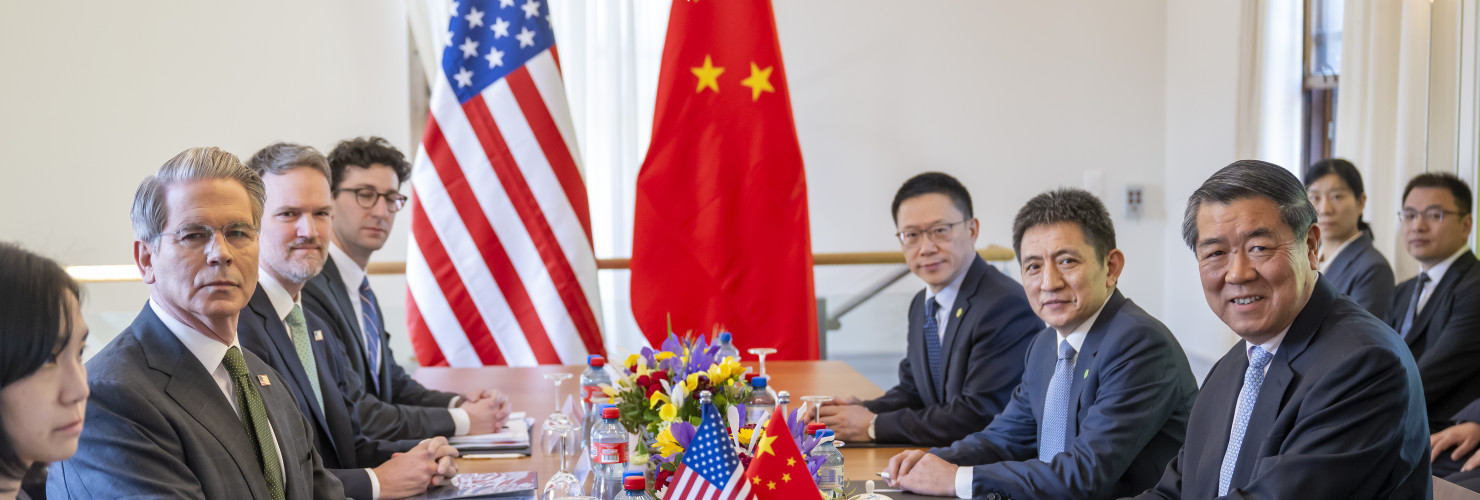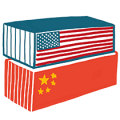

China’s Trump playbook pays off, for now
Despite the impact of US tariffs, China is getting closer to its goal of becoming a global power and reducing the hold that West has over the rules-based international order, says Helena Legarda.
Even as US-China relations enter into ceasefire mode after the trade truce reached in London in mid-June, competition remains the underlying logic in the relationship. Beijing continues to see the United States as an obstacle to its global ambitions and its political stability, and is signaling stronger willingness—and preparedness—to respond in kind to any actions taken by the Trump administration that are seen as a threat to China’s broad understanding of national security.
China has been a key target of Washington’s accusations and policy actions ever since President Donald Trump took office again in January. Trump’s view that China is “ripping us off like nobody’s ever ripped us off” has set the stage for a trade and technology war that is a major source of concern in Beijing. At a time when China’s economic growth is slowing down and social tensions are rising, China’s leaders can ill afford additional pressure on the system.
Despite these tensions, the situation is likely better for Beijing than expected a few weeks ago. While his administration continues to talk about the threat that China poses, Trump himself seems eager to reach an agreement. Beijing’s strategy to deal with the US seems to be working out. Furthermore, Trump’s unilateral and transactional approach to international affairs is creating opportunities for Beijing to improve its global standing and make progress toward key goals at little to no cost to China.
Beijing feels vindicated
The first few weeks of the Trump II administration are sure to have raised some alarms in Beijing. If sustained, the rapid escalation of the tariff war in April—with US tariffs on China reaching a peak of 145 percent at a certain point—and the expansion of tech export controls could have a strong impact on China’s economic development. And Washington’s signals that it might reduce its security commitments to Europe so it could refocus its attention and military capabilities to the Indo-Pacific could create obstacles to China’s regional ambitions.
This time, however, Beijing is signaling that it is ready for the fight. After a few years building up China’s legal, policy, and institutional toolkit to defend the country’s national security and development interests, China’s leadership has gone out of its way to show that it feels confident in its path and in its ability to respond to any US actions. “No country should fantasize that it can suppress China and maintain good relations with China at the same time. Such two-faced acts are not good for the stability of bilateral relations,” said China’s chief diplomat Wang Yi in March.
Beijing’s strategy seems to be based on playing for time while it strengthens its own position. China is responding to US actions with tit-for-tat measures and leveraging its chokehold over critical value chains (such as rare earths) to draw Washington into protracted talks that produce ceasefires but allow it to sidestep the more difficult and structural issues in the relationship. China’s leaders seem to be betting on the fact that Beijing’s appetite for escalation and the Chinese people’s willingness to withstand economic pain are higher than the US public’s. As long as China holds its ground and hits back against US “coercion,” they expect Trump will back down.
And so far, the Trump administration is reinforcing this perspective. The agreements reached in Geneva and London to de-escalate trade tensions and create a “framework” for further talks were seen in Beijing as victories for China’s strategy and, more broadly, as vindication for President Xi Jinping’s approach to foreign policy and to relations with the US. As Xi said in 2023: “History has repeatedly proven that if we seek development through struggle, we will develop and prosper; if we seek development through weakness and concession, we will decline.”
China’s chance
Concerns over the global chaos and uncertainty ushered in by the Trump administration are still present in Beijing. And so are fears that Trump might become frustrated with the talks and escalate the trade and tech war again. But Chinese experts, and likely China’s leaders too, seem cautiously optimistic about China’s chances. This is not just about China’s ability to resist and respond to US actions. As a result of Trump’s actions, Beijing is also seeing opportunities to make progress toward some of its key goals with little effort of its own.
Polarization within the US is seen as a further sign that the “East is rising, and the West is declining”, and is being leveraged to make the case that China’s political system and governance model is as good—if not better—than liberal democratic models.
The dismantling of United States Agency for International Development (USAID), the indiscriminate use of tariffs, and the United States’ withdrawal from multilateral institutions like the World Health Organization or the Paris Agreement are providing Beijing with rhetorical ammunition to argue that the US is not a responsible global actor or a reliable partner. China, in contrast, is portraying itself as a force for peace and a defender of multilateralism and free trade. While China is unlikely to step up and truly fill the vacuum left by the US, it will use this narrative to strengthen its relations with countries across the Global South and continue pushing toward its goal of reforming the current global order. The shutdown of Voice of America and similar US-funded media outlets will only make this easier.
Washington’s disregard for allies, meanwhile, is creating opportunities for China to reengage with frustrated US partners. The transatlantic alliance in particular has been put under strain by Washington’s rapprochement with Russia while the war in Ukraine continues and by Trump’s antagonistic view of the European Union. This is allowing China to launch a charm offensive designed to split Europe from the United States and weaken NATO, all the while preserving and deepening its own partnership with Russia.
Beijing will likely fail to take advantage of all of these opportunities. But China is already enjoying a bump in ratings simply as a result of the decline in Washington’s global image and soft power. Two analyses conducted by Ipsos and Morning Consult in April and May show clear trends: China’s global favorability ratings have now eclipsed those of the US, and Beijing is seen as a more positive influence on world affairs than Washington.
Competition is the baseline
Chinese analysts did not expect major changes to the United States’ China policy to take place after the November 2024 US elections. In their eyes, the broad lines of the US’ China policy, including the view of China’s rise as a threat to be contained, are a rare point of bipartisan consensus in Washington.
This relative consensus, and the fundamental distrust of the United States’ intentions, also came across prominently in a 2024 survey conducted by the Center for International Security and Strategy at Tsinghua University. Over 87 percent of respondents agreed with the statement that the US is trying to contain China’s development, and almost half agreed that the US is trying to conduct “peaceful evolution” in China. The general view is clearly that US-China competition is structural.
So far, the second Trump administration looks like a potentially net positive for Beijing. The Chinese Communist Party (CCP) feels vindicated in Xi Jinping’s approach to international affairs. Domestic support as the party tackles the United States’ “bullying” seems to have increased. China’s global image is improving. And Beijing is working to expand its global influence at the expense of the US. Despite the economic and technological impact of the tariffs and export controls, all of this gets Beijing closer to its goal of becoming a global power and reducing the hold that the US—and the West at large—have over the rules-based international order.
This could admittedly all change. Washington could define a more solid and coherent China strategy at some point that prioritizes competition and cooperation with allies, leaving fewer openings for Beijing. It could follow through on the refocus to the Indo-Pacific, challenging China’s regional ambitions and actions against Taiwan and in the South China Sea. Or it could go back to stricter tech export controls and sky-high tariffs on Chinese products and refuse to negotiate.
Still, and regardless of whether a deal is eventually reached, strategic competition will remain the defining element of China’s approach to the US.
This article was first published by IP Quarterly on June 25, 2025.

